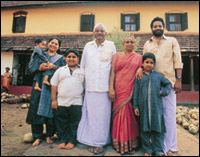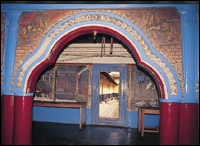


|
|
|
BELIPADY HOUSE in Ananthady, which is 45 kilometres outside Mangalore, is where most South Indian film directors head when they want to shoot period family dramas in ancestral Mangalorean properties. It is a magnificent and old sprawling structure, and it stands stolidly on grounds that extend into a dense plantation of banana, coconut and arecanut trees. To one side of the house is a garden patch on which grows brinjal, pumpkin, ladyfingers, all kinds of beans, the local spinach called basale, a sweet cucumber called taute, tomatoes and other greens. And way beyond is a creek in which tasty mud crab can be found. Ramakrishna Rai is the man of the house. He is a retired agriculturist and his green thumb is evident all about the place. He lives here in splendid isolation with his old wife Sharada, his
son Narendra and daughter-in-law Arthika. Belipady House, the family say, is a "guthu� house, which means it was something of a royal residence in days gone by when one of the ancestors was the Patel of the local village. This is one happy, content family. They cook their meals in old copper, iron and steel vessels on coal and wood fires. Alternatively they also have gobar gas, which is created out of cowdung, and is made in a small plant on the premises itself. What are their meals like? For fish, the Rais depend on what is available in Mangalore. They get pomfret, prawns, shellfish, which they prepare in the form of a curry, fry or chilli-fry. The mud crab, which lives in a creek outside Belipady House, is caught by the servants of the house and is a very tasty item of seafood.
|

Home Page
About the mag
Subscribe
Advertise
Contact Us
 Lifestyle In Rural Mangalore!
Lifestyle In Rural Mangalore!
 The family that lives in Belipady House, a Bunt family of Rais, are self-sufficient for their food needs. Everything either grows there or is locally available. They have rice fields on which grow the popular local varieties Mussorie and Surya. The rice grains are parboiled with their husks, then dried in the sun, and stored in a dark room after being securely packed in straw and jute. This is done to retain the proteins and vitamins. And the Rais keep poultry, they rear cattle, for their chicken, eggs and milk. They rarely eat mutton.
The family that lives in Belipady House, a Bunt family of Rais, are self-sufficient for their food needs. Everything either grows there or is locally available. They have rice fields on which grow the popular local varieties Mussorie and Surya. The rice grains are parboiled with their husks, then dried in the sun, and stored in a dark room after being securely packed in straw and jute. This is done to retain the proteins and vitamins. And the Rais keep poultry, they rear cattle, for their chicken, eggs and milk. They rarely eat mutton.
 Chicken is the staple diet. They keep poultry, about 50 country chicken, which Mangaloreans say is the more delicious variety.
And they also rear about 12 fighting cocks. These are put to contest in cock fights in the village round about the time of the Mechi festival in February in honour of Goddess Ullalthi, the local deity. One cock either dies or runs away from the fight. The Rais cook and eat the fighting cocks too. They are said to be a delicacy. Their chicken dishes are standard Mangalorean fare, the kori rotti, sukha and curry. All made with a little green chilli, coriander, tamarind, jeera, some methi seeds and onion... all grown at home, naturally.
Chicken is the staple diet. They keep poultry, about 50 country chicken, which Mangaloreans say is the more delicious variety.
And they also rear about 12 fighting cocks. These are put to contest in cock fights in the village round about the time of the Mechi festival in February in honour of Goddess Ullalthi, the local deity. One cock either dies or runs away from the fight. The Rais cook and eat the fighting cocks too. They are said to be a delicacy. Their chicken dishes are standard Mangalorean fare, the kori rotti, sukha and curry. All made with a little green chilli, coriander, tamarind, jeera, some methi seeds and onion... all grown at home, naturally.
 Arecanut is their main crop. They dry the fruit and seek the supari which is then sold at the village "santhe", an auction, every now and then. Coconuts are their main business. A team of labourers is at work round the year at Belipady House, drying the coconuts, removing the shell and selling them for Rs. 3.50 each. They have mango trees as well on which grow Alphonso, Totapuri, Neelam and local varieties like Mangalpadi and Mundapa. These are not sold but kept for the family's consumption.
Arecanut is their main crop. They dry the fruit and seek the supari which is then sold at the village "santhe", an auction, every now and then. Coconuts are their main business. A team of labourers is at work round the year at Belipady House, drying the coconuts, removing the shell and selling them for Rs. 3.50 each. They have mango trees as well on which grow Alphonso, Totapuri, Neelam and local varieties like Mangalpadi and Mundapa. These are not sold but kept for the family's consumption.